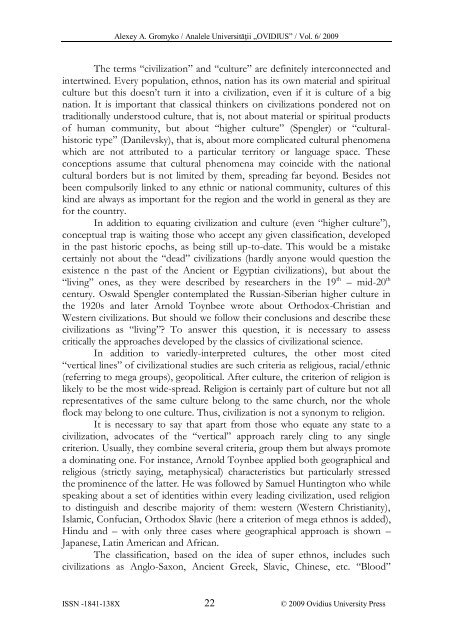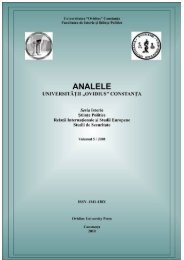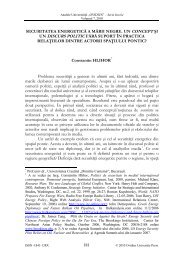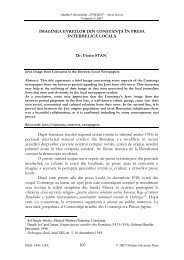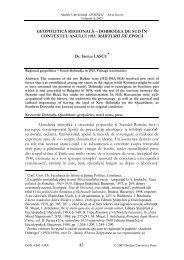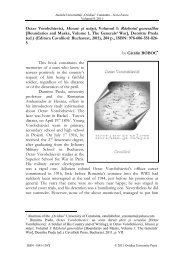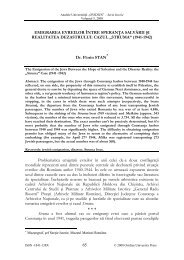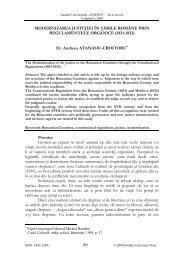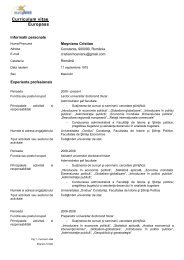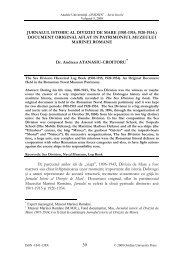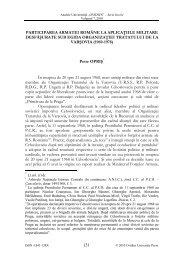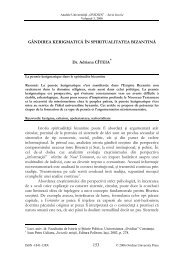analele universitÄÅ£ii âovidiusâ constanÅ£a - AUOCSI
analele universitÄÅ£ii âovidiusâ constanÅ£a - AUOCSI
analele universitÄÅ£ii âovidiusâ constanÅ£a - AUOCSI
Create successful ePaper yourself
Turn your PDF publications into a flip-book with our unique Google optimized e-Paper software.
Alexey A. Gromyko / Analele Universităţii „OVIDIUS” / Vol. 6/ 2009<br />
The terms “civilization” and “culture” are definitely interconnected and<br />
intertwined. Every population, ethnos, nation has its own material and spiritual<br />
culture but this doesn’t turn it into a civilization, even if it is culture of a big<br />
nation. It is important that classical thinkers on civilizations pondered not on<br />
traditionally understood culture, that is, not about material or spiritual products<br />
of human community, but about “higher culture” (Spengler) or “culturalhistoric<br />
type” (Danilevsky), that is, about more complicated cultural phenomena<br />
which are not attributed to a particular territory or language space. These<br />
conceptions assume that cultural phenomena may coincide with the national<br />
cultural borders but is not limited by them, spreading far beyond. Besides not<br />
been compulsorily linked to any ethnic or national community, cultures of this<br />
kind are always as important for the region and the world in general as they are<br />
for the country.<br />
In addition to equating civilization and culture (even “higher culture”),<br />
conceptual trap is waiting those who accept any given classification, developed<br />
in the past historic epochs, as being still up-to-date. This would be a mistake<br />
certainly not about the “dead” civilizations (hardly anyone would question the<br />
existence n the past of the Ancient or Egyptian civilizations), but about the<br />
“living” ones, as they were described by researchers in the 19 th – mid-20 th<br />
century. Oswald Spengler contemplated the Russian-Siberian higher culture in<br />
the 1920s and later Arnold Toynbee wrote about Orthodox-Christian and<br />
Western civilizations. But should we follow their conclusions and describe these<br />
civilizations as “living” To answer this question, it is necessary to assess<br />
critically the approaches developed by the classics of civilizational science.<br />
In addition to variedly-interpreted cultures, the other most cited<br />
“vertical lines” of civilizational studies are such criteria as religious, racial/ethnic<br />
(referring to mega groups), geopolitical. After culture, the criterion of religion is<br />
likely to be the most wide-spread. Religion is certainly part of culture but not all<br />
representatives of the same culture belong to the same church, nor the whole<br />
flock may belong to one culture. Thus, civilization is not a synonym to religion.<br />
It is necessary to say that apart from those who equate any state to a<br />
civilization, advocates of the “vertical” approach rarely cling to any single<br />
criterion. Usually, they combine several criteria, group them but always promote<br />
a dominating one. For instance, Arnold Toynbee applied both geographical and<br />
religious (strictly saying, metaphysical) characteristics but particularly stressed<br />
the prominence of the latter. He was followed by Samuel Huntington who while<br />
speaking about a set of identities within every leading civilization, used religion<br />
to distinguish and describe majority of them: western (Western Christianity),<br />
Islamic, Confucian, Orthodox Slavic (here a criterion of mega ethnos is added),<br />
Hindu and – with only three cases where geographical approach is shown –<br />
Japanese, Latin American and African.<br />
The classification, based on the idea of super ethnos, includes such<br />
civilizations as Anglo-Saxon, Ancient Greek, Slavic, Chinese, etc. “Blood”<br />
ISSN -1841-138X 22 © 2009 Ovidius University Press


